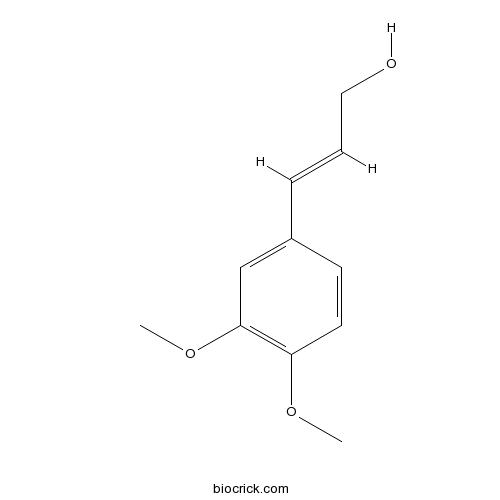3,4-Dimethoxycinnamyl alcoholCAS# 40918-90-9 |

Quality Control & MSDS
3D structure
Package In Stock
Number of papers citing our products

| Cas No. | 40918-90-9 | SDF | Download SDF |
| PubChem ID | 5387770 | Appearance | Powder |
| Formula | C11H14O3 | M.Wt | 194.2 |
| Type of Compound | Phenylpropanoids | Storage | Desiccate at -20°C |
| Solubility | Soluble in Chloroform,Dichloromethane,Ethyl Acetate,DMSO,Acetone,etc. | ||
| Chemical Name | (E)-3-(3,4-dimethoxyphenyl)prop-2-en-1-ol | ||
| SMILES | COC1=C(C=C(C=C1)C=CCO)OC | ||
| Standard InChIKey | OYICGYUCCHVYRR-ONEGZZNKSA-N | ||
| Standard InChI | InChI=1S/C11H14O3/c1-13-10-6-5-9(4-3-7-12)8-11(10)14-2/h3-6,8,12H,7H2,1-2H3/b4-3+ | ||
| General tips | For obtaining a higher solubility , please warm the tube at 37 ℃ and shake it in the ultrasonic bath for a while.Stock solution can be stored below -20℃ for several months. We recommend that you prepare and use the solution on the same day. However, if the test schedule requires, the stock solutions can be prepared in advance, and the stock solution must be sealed and stored below -20℃. In general, the stock solution can be kept for several months. Before use, we recommend that you leave the vial at room temperature for at least an hour before opening it. |
||
| About Packaging | 1. The packaging of the product may be reversed during transportation, cause the high purity compounds to adhere to the neck or cap of the vial.Take the vail out of its packaging and shake gently until the compounds fall to the bottom of the vial. 2. For liquid products, please centrifuge at 500xg to gather the liquid to the bottom of the vial. 3. Try to avoid loss or contamination during the experiment. |
||
| Shipping Condition | Packaging according to customer requirements(5mg, 10mg, 20mg and more). Ship via FedEx, DHL, UPS, EMS or other couriers with RT, or blue ice upon request. | ||
| Description | 1. 3,4-Dimethoxycinnamyl alcohol shows significant antimicrobial and cytotoxic activities. |
| Targets | Antifection |

3,4-Dimethoxycinnamyl alcohol Dilution Calculator

3,4-Dimethoxycinnamyl alcohol Molarity Calculator
| 1 mg | 5 mg | 10 mg | 20 mg | 25 mg | |
| 1 mM | 5.1493 mL | 25.7467 mL | 51.4933 mL | 102.9866 mL | 128.7333 mL |
| 5 mM | 1.0299 mL | 5.1493 mL | 10.2987 mL | 20.5973 mL | 25.7467 mL |
| 10 mM | 0.5149 mL | 2.5747 mL | 5.1493 mL | 10.2987 mL | 12.8733 mL |
| 50 mM | 0.103 mL | 0.5149 mL | 1.0299 mL | 2.0597 mL | 2.5747 mL |
| 100 mM | 0.0515 mL | 0.2575 mL | 0.5149 mL | 1.0299 mL | 1.2873 mL |
| * Note: If you are in the process of experiment, it's necessary to make the dilution ratios of the samples. The dilution data above is only for reference. Normally, it's can get a better solubility within lower of Concentrations. | |||||

Calcutta University

University of Minnesota

University of Maryland School of Medicine

University of Illinois at Chicago

The Ohio State University

University of Zurich

Harvard University

Colorado State University

Auburn University

Yale University

Worcester Polytechnic Institute

Washington State University

Stanford University

University of Leipzig

Universidade da Beira Interior

The Institute of Cancer Research

Heidelberg University

University of Amsterdam

University of Auckland

TsingHua University

The University of Michigan

Miami University

DRURY University

Jilin University

Fudan University

Wuhan University

Sun Yat-sen University

Universite de Paris

Deemed University

Auckland University

The University of Tokyo

Korea University
- Sinoacutine
Catalog No.:BCN5461
CAS No.:4090-18-0
- H-Tyr-OEt.HCl
Catalog No.:BCC3125
CAS No.:4089-07-0
- 3,5-Dihydroxy-1,7-bis(3,4-dihydroxyphenyl)heptane
Catalog No.:BCN7494
CAS No.:408324-01-6
- 3,5-Dihydroxy-1-(3,4-dihydroxyphenyl)-7-(4-hydroxyphenyl)heptane
Catalog No.:BCN7165
CAS No.:408324-00-5
- Suprofen
Catalog No.:BCC4943
CAS No.:40828-46-4
- MDL 72222
Catalog No.:BCC6733
CAS No.:40796-97-2
- H-D-Asp(OBzl)-OBzl.TosOH
Catalog No.:BCC2900
CAS No.:4079-64-5
- PD 146176
Catalog No.:BCC7504
CAS No.:4079-26-9
- FPL 55712
Catalog No.:BCC7310
CAS No.:40785-97-5
- 1,7-Diepi-8,15-cedranediol
Catalog No.:BCN5460
CAS No.:40768-81-8
- CaCCinh-A01
Catalog No.:BCC6314
CAS No.:407587-33-1
- (+)-Nerolidol
Catalog No.:BCC8219
CAS No.:142-50-7
- JNJ 16259685
Catalog No.:BCC7332
CAS No.:409345-29-5
- VU0152100
Catalog No.:BCC4053
CAS No.:409351-28-6
- Taxiresinol
Catalog No.:BCN4637
CAS No.:40951-69-7
- Glycitein
Catalog No.:BCN5896
CAS No.:40957-83-3
- Medioresinol
Catalog No.:BCN5462
CAS No.:40957-99-1
- Desacetylcinobufotalin
Catalog No.:BCC8166
CAS No.:4099-30-3
- H-D-Ala-OBzl.TosOH
Catalog No.:BCC2850
CAS No.:41036-32-2
- Palovarotene
Catalog No.:BCC4185
CAS No.:410528-02-8
- Sirtinol
Catalog No.:BCC2224
CAS No.:410536-97-9
- Timosaponin A3
Catalog No.:BCN4999
CAS No.:41059-79-4
- Lipiferolide
Catalog No.:BCN5463
CAS No.:41059-80-7
- Neobavaisoflavone
Catalog No.:BCN3194
CAS No.:41060-15-5
Antileishmanial phenylpropanoids from Alpinia galanga (Linn.) Willd.[Pubmed:21046987]
Indian J Exp Biol. 2010 Mar;48(3):314-7.
Hexane, chloroform and ethyl acetate extracts (100 microg/ml) of Alpinia galanga rhizomes exhibited significant activity in vitro against promastigotes of L. donovani. Twelve compounds namely, methyleugenol (1), p-coumaryl diacetate (2), 1'-acetoxychavicol acetate (3), 1'-acetoxyeugenol acetate (4), trans-p-acetoxycinnamyl alcohol (5), trans-3,4-Dimethoxycinnamyl alcohol (6), p-hydroxybenzaldehyde (7), p-hydroxycinnamaldehyde (8), trans-p-coumaryl alcohol (9), galangin (10), trans-p-coumaric acid (11) and galanganol B (12) were isolated from these extracts. Of these, compounds 2, 3, 4 and 5 were found most active in vitro against promastigotes of L. donovani with IC50 values of 39.3, 32.9, 18.9 and 79.9 microM respectively. This is the first report of antileishmanial activity of the extracts and isolated constituents of A. galanga.
Antimicrobial and cytotoxic constituents of Loranthus globosus.[Pubmed:12727502]
Fitoterapia. 2003 Apr;74(3):308-11.
(+)-Catechin, 3,4-Dimethoxycinnamyl alcohol and 3,4,5-trimethoxycinnamyl alcohol were isolated from the barks of Loranthus globosus. All compounds showed significant antimicrobial and cytotoxic activities.


